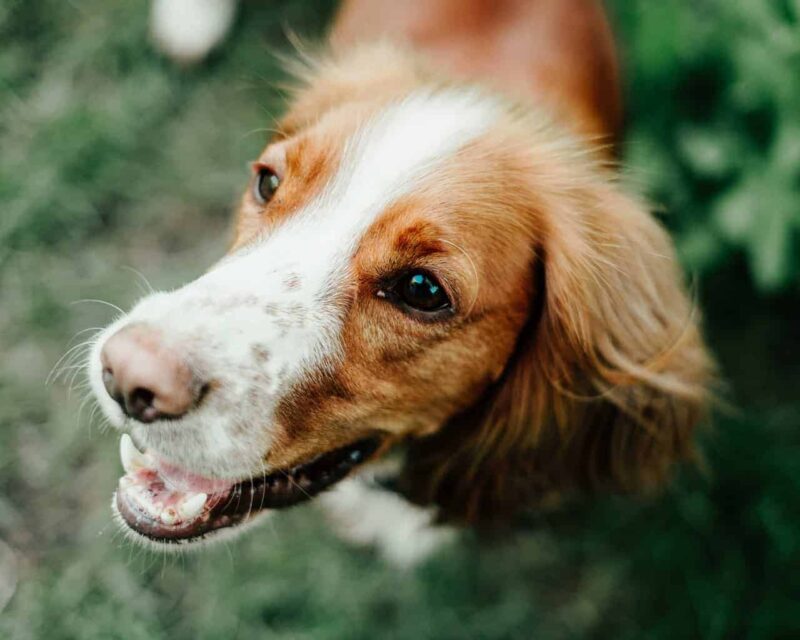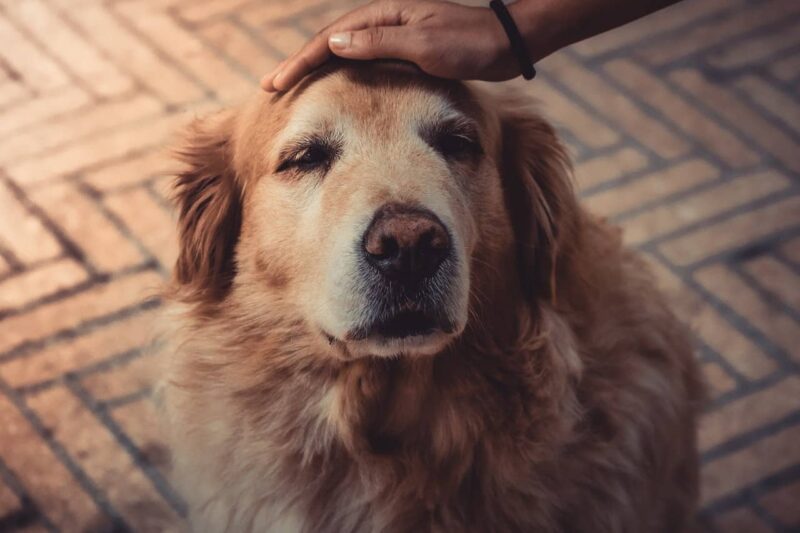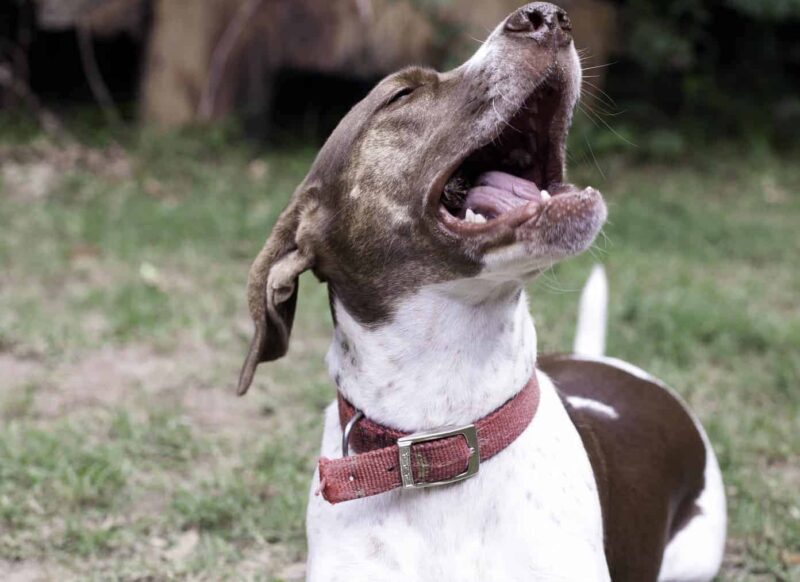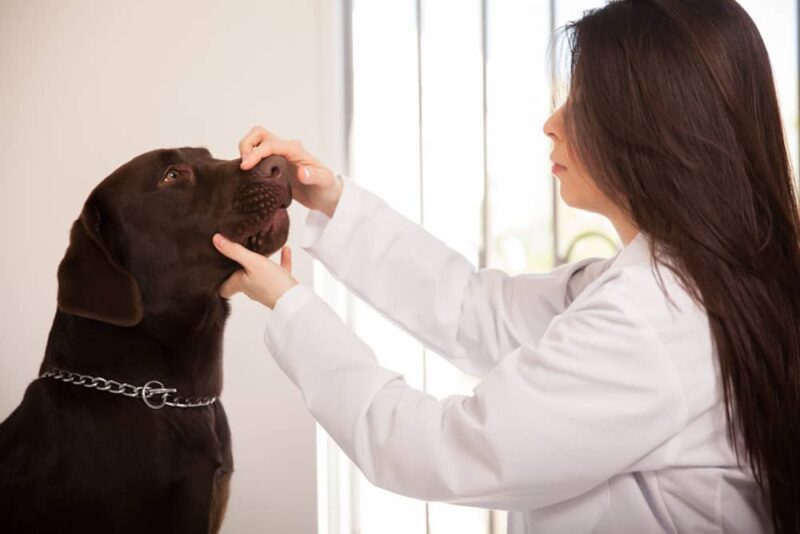Dogs are well known for biting and chewing on anything they can get their paws on, but have you recently noticed your dog chewing with nothing in its mouth at all?
If you find your dog making weird mouth movements for no visible reason, there are a number of possible underlying causes.
Your pup may be trying to dislodge foreign objects stuck between its teeth, or it could be suffering from oral and dental issues such as teething or tooth decay.
Chewing on nothing can also be a developed habit or conditioned behavior caused by reinforcement or absence of training.
Stomach issues primarily relating to nausea can also be the cause of chewing as dogs will often move their mouth around to prevent vomiting, or to stop excess saliva from dripping out.
Finally, neurological problems such as seizures, distemper and Cognitive Dysfunction Syndrome are also some of the more common medical issues that may cause canines to chew with nothing in their mouths.
Why Does My Dog Look Like He’s Chewing Gum?

When dogs appear to be chewing gum, they could in actual fact be chewing in an attempt to remove a foreign object lodged somewhere within its mouth. The foreign material could be anything ranging from food, wood splinters, or small pieces of metal or plastic.
In other cases, your dog may be overly excited, feeling anxious due to unfamiliar noises or people, or simply too cold. In these situations your dog may chatter its teeth, which can make it appear as if it is chewing gum.
Another relatively harmless explanation for this chewing phenomenon in dogs is habit.
Like humans, dogs can develop harmless abnormal habits that can usually be reduced through training or time. You can easily condition your dog to stop the chewing action by rewarding them with treats or praise whenever they stop.
Moderately Serious Possible Causes
More serious possible explanations for imaginary gum chewing can include muscle spasms and nausea.
Muscle Spasms
Twitching of the jaw muscles can be caused by excessive strain, jaw injuries, dehydration, allergies or medication. With sufficient rest, hydration and physical therapy, spasms can usually be quickly resolved.
Nausea
When dogs become nauseated, they will produce more saliva as their body prepares to protect the internal lining of organs from the acidic vomit. Your dog may chew or gulp saliva to prevent it from drooling out.
Most Serious Possible Causes

The most urgent explanations for imaginary gum chewing involve issues such as seizures and meningitis, as well as the viral condition distemper.
Localized Epilepsy
Abnormal activation of neural circuits controlling the jaw muscles can cause irregular stimulation and movement, leading to the chewing gum motion.
Meningitis
Inflammation of membranes in the brain and spinal cord can lead to pain, fever, neck rigidness and muscle spasms.
There are various causes of this condition, the most common of which include viruses, fungi, protozoa and rickettsia.
Meningitis can be diagnosed by examining a dog’s cerebrospinal fluid.
Treatment is likely to involve corticosteroids, antibiotics or certain antifungal medication.
Recovery will be dependent on three factors including:
- The cause of meningitis
- The severity of meningitis
- Degree of damage caused to the nervous system
Distemper
Distemper is a viral condition which is rare in vaccinated dogs but prevalent among those unvaccinated. The virus hinders the function of the nervous system, respiratory system and digestive system.
The virus is often transmitted from wild animals and can be passed on by airborne exposure, bodily fluids or shared food and water. It can take up to 4 weeks before symptoms begin to show.
The chewing motion is a result of the virus affecting the nervous system and causing continuous muscle twitches, convulsions and abnormal jaw movements known as chewing gum fits.
Diagnosis of distemper will include physical procedures such as conjunctival smears, blood tests, examination of the cerebrospinal fluid, autopsies, and dry eye tests.
Common symptoms of distemper include:
- Teary eyes
- Diarrhea
- Drooling
- Teeth chattering
- Nasal discharge
- Fever
- Loss of appetite
- High fever
- Coughing
- Vomiting
In severe cases of distemper, other symptoms will appear including:
- Lymphopenia
- Pneumonia
- Conjunctivitis
Why Does My Dog Keep Chewing Air?

As already mentioned above, there are a variety of reasons as to why your dog might be chewing air.
A common cause may be one borne out of habit. Dogs will continually chew on air if the behavior was not previously corrected or has been reinforced further by human owners.
Another common reason is that your dog may have foreign material stuck somewhere in its mouth.
This could be anything from hairs, splinters, or pieces of food (such as boswellia) lodged between the teeth or stuck on the roof of the mouth. You may also see your dog rubbing its face in an attempt to remove the stuck object.
Otherwise, dental issues which can cause air chewing include tooth decay and sore teeth.
Problems such as tooth abscesses, periodontal disease, gum pain, oral swelling, loose or bad teeth, gingivitis, oral lesions and bug stings are just some of the dental reasons that could cause dogs to chew air.
Air chewing can also be more prominent in puppies while they are teething. To prevent their teeth from constantly touching the sore region, a puppy may keep opening and closing its mouth repeatedly.
In some cases of air chewing, your dog may be suffering from sialocele- the pooling of saliva due to an infection or trauma.
You can check if this is the case by looking under your dog’s tongue where the salivary gland is located to see if there is any swelling present. Fortunately, sialocele can be easily resolved by surgical draining.
In addition to oral or dental problems, air chewing can be a result of compulsive behavior, emotional distress, GI issues, and neural problems.
Compulsive Behavior And Emotional Distress
Chewing air can be a sign of compulsive behavior. Your dog may have compulsive disorders that are triggered under specific emotional scenarios such as stress, frustration, boredom, want for attention, or anxiety.
Other signs of stress, frustration and anxiety can include hiding and inappropriate elimination. Emotional distress can be the result of loud noises, new environments, new people or strange smells.
Digestive issues
Dogs chewing air or licking the floor and coughing can be a clear sign of stomach discomfort, pain, intestinal blockage, bloating or nausea.
If it has consumed something disgusting, inappropriate or poisonous, this can then result in obvious bowel problems.
Nausea naturally induces the excess production of saliva in order to protect the inner walls of organs so that damage by acidic vomit is minimized. Your dog may open and close its mouth while smacking its lips to stop leakage of saliva.
Neural Problems

Problems with neural circuits can lead to repetitive behavior. Some potential neural causes of air chewing include canine cognitive dysfunction, seizures and fly-biting syndrome.
Canine Cognitive Dysfunction
Canine cognitive dysfunction is a condition similar to dementia or Alzheimer’s in humans. It commonly appears with old age and involves involuntary repetitive behavior.
Cognitive dysfunction can be delayed through medication, healthy diet, and regular exercise.
Seizures
Your dog may have an underlying condition, or may have consumed something toxic which has affected their neural networks. A common example is the fly-biting syndrome.
Fly-Biting Syndrome
Fly-biting syndrome is a partial seizure caused by abnormal electrical activity in a localized area of the brain. It is commonly associated with underlying disorders, specifically GI diseases.
Fly-biting can usually be found alongside an inflamed digestive tract, acid reflux and a flaccid or distended stomach. Fly-biting is often preceded by head raising and neck extension.
In rare cases, medical issues that lead to air chewing can include:
- Irritable Bowel Syndrome: Chronic inflammation of the bowel linings which can cause nausea, stomach pain and diarrhea.
- Pancreatitis: Inflammation of the pancreas with symptoms including dehydration, lethargy and fever.
- Esophagitis: Inflammation and irritation of the esophagus often caused by acid reflux.
- Giardiasis” An intestinal infection with signs including weight loss and intermittent foul-smelling diarrhea.
Why Does My Dog Move Her Mouth Like She’s Talking?

If your dog moves their mouth but does not create much noise, they could be trying to dislodge something stuck between their teeth.
Other dental or oral issues like problems with their teeth or gums can prevent your dog from biting down. This could be due to pain from teething in puppies or other dental conditions such as tooth decay.
In cases where your dog is suffering from tooth decay or gum disease, you may see blood in your dog’s water bowl.
A nauseated dog’s jaw will also undergo involuntary spasms and will cause them to rub their tongue against the roof of their mouth to prevent vomiting. Furthermore, your dog may adjust their mouth to move the excess saliva produced.
When dogs move their mouth as if they’re talking, it could also be a conditioned response. As owners may respond positively when their dog attempts to talk, random movement of the mouth can become an encouraged behavior as they learn that they will receive attention or rewards.
Potential neurological issues such as distemper and seizures can also explain irregular talking movements. Abnormal activation of the nervous system from these conditions can involuntarily move your dog’s jaw muscles.
What Can I Do If My Dog Keeps Chewing With Nothing In Its Mouth?

You should firstly check if your dog is choking. They could be coughing in an attempt to expel foreign material stuck within its throat. Some signs of choking include difficulty inhaling, panicking, and pawing at either their head or the mouth.
If you suspect your dog is choking, check inside your dog’s mouth to see if there’s anything in their throat or their mouth. If possible, try to remove it with your fingers.
If it looks like a sharp object such as a bone shard or stick, take your dog to the vet immediately for help as any laceration can be dangerous.
If you cannot remove the object with your finger, immediately either perform the Heimlich maneuver or drive your dog to the vet who may then sedate your dog to remove the object.
If your dog does not appear to be choking, you can try to distract your dog with toys or rewards to stop their behavior. If they do stop, it can suggest that the air chewing is a habit or a conditioned behavior.
In this situation, consult with an animal behaviorist for training and reconditioning.
When a dog chews with nothing in its mouth, there are several factors you will need to check, including:
- Daily diet
- Previously chewed objects
- Level of emotional distress
- Level of stimulation, interest and exercise
- Dental health
If your dog is not getting enough nutrients, has something stuck within its mouth, feels stressed or frustrated, does not get enough stimulation daily, or has dental issues, these will need to be addressed as potential causes.
Never hesitate to take your dog to the vet as they will be able examine your dog using an x-ray.
Whenever you see your dog chewing on nothing, it would be best to record the behavior in a video so that you can show your vet exactly what is happening.
You should also provide details including:
- How often the behavior occurs
- If the chewing happens in response to any stimulus
- When it first started
- Specific times of day when it usually occurs
- Known cognitive health issues of your dog.
This information should help your vet diagnose the condition. Several physical examinations may be required including urinalysis, blood work, biochemistry profile, and preliminary neurological observation.
If distemper is the issue, your vet will prescribe antibiotics, antiemetic drugs and multivitamins. In severe cases, IV fluids will be given through a tube or orally. Vaccination will also be required to prevent further instances of distemper and to promote recovery.
In Conclusion
When you find your dog chewing with nothing in its mouth, some relatively harmless explanations can include small objects being stuck between its teeth, and formed habits or conditioned behavior.
Moderately serious problems associated with chewing on nothing include nausea, muscle spasms and dental issues such as tooth abscesses or gum pain.
Severe possibilities that can cause the behavior include episodes of seizure, such as fly-biting syndrome, and canine distemper.
As chewing can be a result of many reasons, the best thing to do is to consult with your vet first. They will be best suited to provide a more conclusive answer, as well as the appropriate treatment that will keep your pup safe and healthy.
Elena Gherman is a highly skilled and knowledgeable animal care expert. At the start of her career, she gained practical expertise with multiple animals. In addition to that, she works as a DVM veterinary editor for Joy Pet Products, which focuses on offering reliable information on pet health and wellbeing. She meticulously reviews each piece of writing before it is published to make sure pet owners get the most precise and updated information possible.
